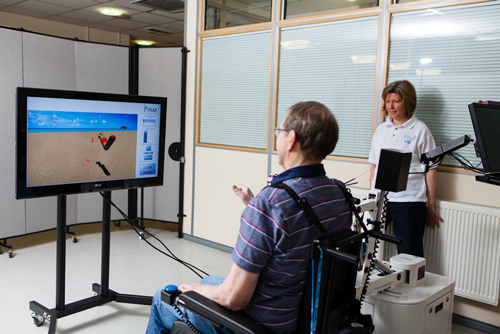Intelligent Pneumatic Arm Movement (iPAM)

Research lead
Professor Martin Levesley
Research team
Dr Andrew Jackson, Dr Rory O’Connor, Dr Pete Culmer
Research grants
NIHR NEAT E027, NIHR HTD 475, NIHR NEAT L030
Stakeholders
National Institute for Health Research (NIHR), Chas A Blatchford & Sons Ltd, Skene Software, Scottish Health Innovations Limited (SHIL), National Instruments.
Project Overview
iPAM is a robot system for providing targeted upper-limb exercise to people with arm movement deficit as a result of stroke. Consisting of two pneumatically powered robot arms, the system mimics the way a physiotherapist provides assistive exercise to a patient’s upper-limb, holding the arm in two places and coordinating the joints to promote normal movement patterns. The system can assist a wide range of patients undertake targeted therapeutic exercise with only indirect therapist supervision, potentially increasing the duration spent undertaking physiotherapy, resulting in an improved outcome for the patient.
Research
iPAM is a robot rehabilitation system designed to deliver assisted exercise of the upper-limb during reaching exercises. Developed by a multi-disciplinary research team including engineers, clinicians, psychologists, physiotherapists and people with stroke and their carers, the system is designed to augment, not replace traditional physiotherapy.
iPAM consists of two identical robot arms: the distal robot orthosis allows control of the movement of the patients forearm while the proximal robot orthosis is attached at the mid-point on the upper arm to control proximal arm movement in relation to distal arm movement. With a total of six active degrees of freedom (DoF) it is possible to control six DoF of the upper-limb (five DoF at the shoulder and one DoF at the elbow).
The control scheme is modelled around a model of the human arm, ensuring safe co-operation between the two robot arms. In order for this to work, the human arm needs to be calibrated within the system such that the robot knows where on the human arm the robots are attached; from this is it possible to match the human arm model in software with the patient’s actual arm. Once calibrated, the physiotherapist is able to create an exercise prescription for the patient based on their individual clinical need. This prescription can then be delivered by iPAM with indirect supervision of the physiotherapist. iPAM will automatically generate exercise patterns based on the category of exercise determined appropriate by the physiotherapist. The patient is then required to attempt to undertake the prescribed task, using a virtual workspace containing targets located in 3D space. iPAM will assist to the patient to reach these virtual targets. The level of assistance and/or size of workspace will automatically adjust based on patient performance and treatment strategy. A typical 1 hour session of robotic therapy with consist of 15 minutes set-up time (including attachment and detachment of the robot) and 45 minutes of robot assisted exercise with direct physiotherapy intervention only required for the set-up time.
The iPAM system is currently in its second version and has recently completed a Randomised Control Trial within 3 different acute stroke services within the National Health Service (NHS). The iPAM systems were used exclusively by physiotherapists and physiotherapist assistants to deliver addition upper-limb exercise to patients post-stroke. The trial completed successfully with no adverse events, demonstrating the system is safe for use with a range of patients within a hospital setting.
Impact
The iPAM is the first robotic system of its type to have been deployed within an acute-stroke setting in the NHS. It has the potential to increase the amount of time patients can spend undertaking upper-limb exercise with the same level of physiotherapy resource.
References
Development of the iPAM MkII system and description of a randomized control trial with acute stroke patients. Jackson AE, Levesley MC, Makower SG, Bhakta BB, Cozens JA, 2013 IEEE International Conference on Rehabilitation Robotics (ICORR)
A novel robotic system for quantifying arm kinematics and kinetics: description and evaluation in therapist-assisted passive arm movements post-stroke. Culmer PR, Jackson AE, Makower SG, Cozens JA, Levesley MC, Mon-Williams M, Bhakta B, Journal of Neuroscience Methods 197(2):259-269 30 Apr 2011.
